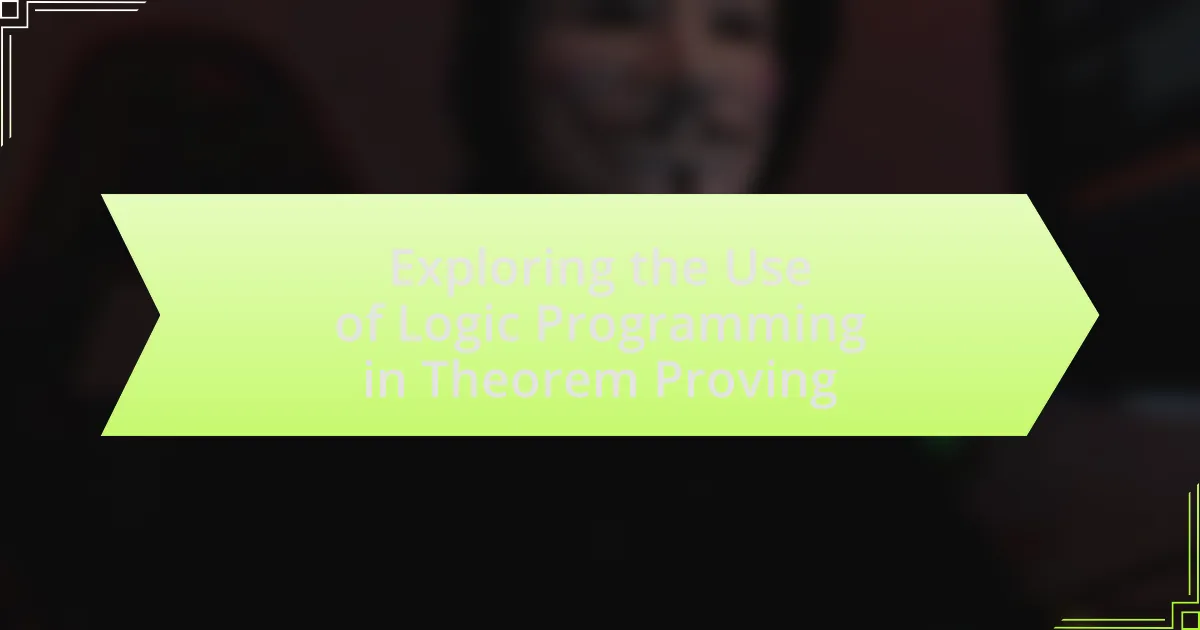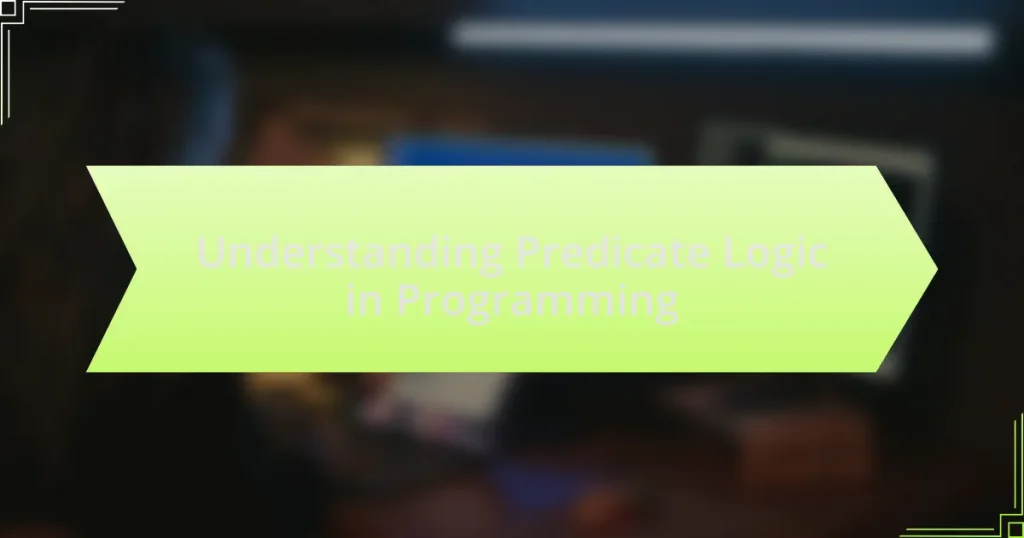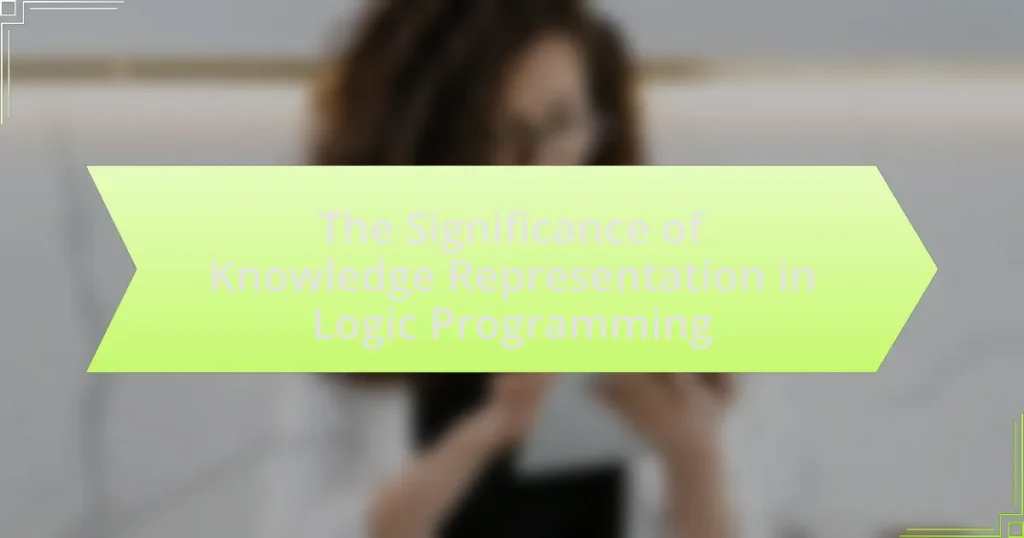Logic programming is a computational paradigm that employs formal logic to represent knowledge and facilitate automated reasoning, particularly in theorem proving. This article explores the relationship between logic programming and theorem proving, highlighting the principles, key components, and programming languages involved, such as Prolog. It addresses the advantages and challenges of using logic programming in theorem proving, including issues of expressiveness, computational complexity, and scalability. Additionally, the article examines the role of automation, recent advancements, and practical applications across various industries, emphasizing best practices for effective implementation in real-world problem-solving scenarios.
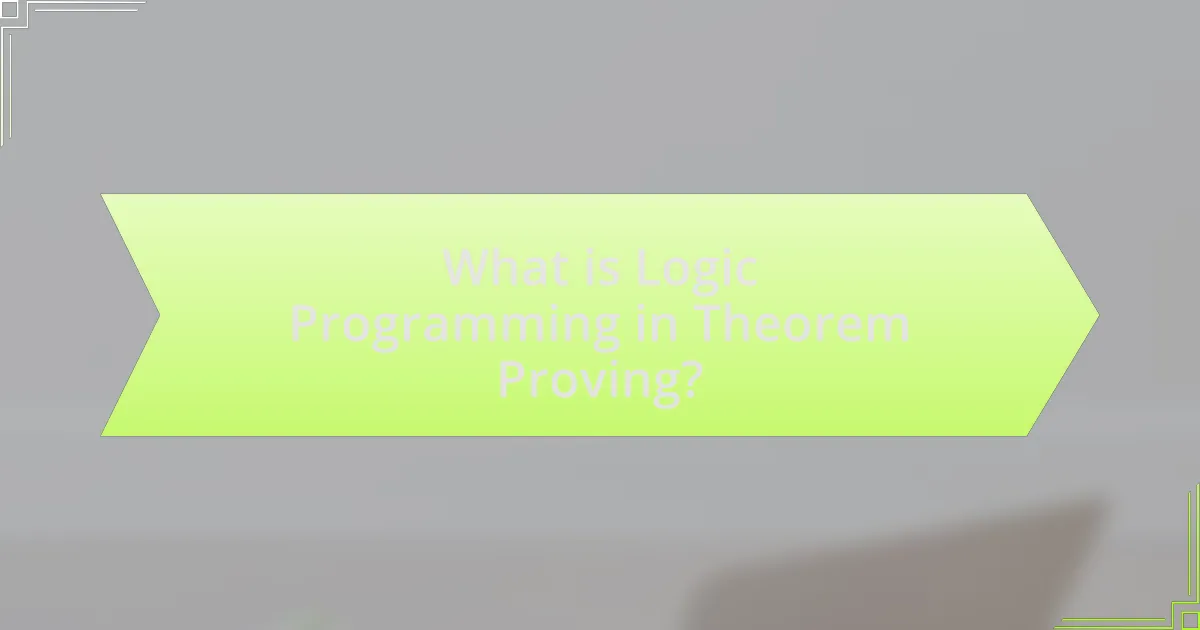
What is Logic Programming in Theorem Proving?
Logic programming in theorem proving is a paradigm that utilizes formal logic to represent knowledge and derive conclusions through automated reasoning. This approach allows for the formulation of problems in a way that can be processed by computers, enabling the verification of logical statements and the discovery of proofs. Logic programming languages, such as Prolog, facilitate this by allowing users to define facts and rules, which the theorem prover can then use to infer new information or validate existing propositions. The effectiveness of logic programming in theorem proving is evidenced by its application in various domains, including artificial intelligence and formal verification, where it has been instrumental in solving complex logical problems efficiently.
How does Logic Programming relate to Theorem Proving?
Logic programming is fundamentally related to theorem proving as it provides a formal framework for expressing logical statements and deriving conclusions based on those statements. In logic programming, programs are expressed as sets of logical clauses, and the execution of these programs involves searching for proofs of queries, which aligns closely with the objectives of theorem proving. Theorem proving systems utilize similar logical foundations to validate the correctness of mathematical statements or logical assertions, often employing algorithms that resemble the resolution strategies used in logic programming. This relationship is evident in systems like Prolog, where the underlying mechanisms for query resolution can be viewed as a form of automated theorem proving, demonstrating that both fields share common methodologies and goals in formal reasoning.
What are the fundamental principles of Logic Programming?
The fundamental principles of Logic Programming include the use of formal logic as a programming paradigm, the representation of knowledge through facts and rules, and the execution of programs via a process of logical inference. Logic Programming is based on the idea that programs can be expressed as a set of logical statements, where the computation is performed by deriving conclusions from these statements using a process called resolution. This approach allows for declarative programming, where the focus is on what the program should accomplish rather than how to achieve it. The validity of these principles is supported by the success of languages like Prolog, which is widely used in artificial intelligence and theorem proving, demonstrating the effectiveness of logic-based reasoning in solving complex problems.
How is Theorem Proving defined within the context of Logic Programming?
Theorem proving in the context of logic programming is defined as a method for establishing the validity of logical statements through formal deduction. This process utilizes a set of axioms and inference rules to derive conclusions from premises, enabling automated reasoning about propositions. Logic programming languages, such as Prolog, facilitate theorem proving by allowing users to express knowledge in a declarative form, where the logic of the program specifies what is true rather than how to compute it. The effectiveness of theorem proving in logic programming is evidenced by its application in various domains, including artificial intelligence and formal verification, where it has been used to prove properties of systems and algorithms systematically.
What are the key components of Logic Programming in Theorem Proving?
The key components of Logic Programming in Theorem Proving include a formal syntax, a semantics that defines the meaning of expressions, and a proof procedure for deriving conclusions. The formal syntax consists of logical statements and rules that can be manipulated, while the semantics provides a framework for interpreting these statements. The proof procedure, often based on resolution or other inference techniques, allows for the systematic derivation of theorems from axioms and previously established results. These components work together to facilitate automated reasoning and verification in various applications, such as software verification and artificial intelligence.
What programming languages are commonly used in Logic Programming?
Commonly used programming languages in Logic Programming include Prolog, Mercury, and Lisp. Prolog is the most recognized language specifically designed for logic programming, enabling the expression of facts and rules in a declarative manner. Mercury extends Prolog’s capabilities with strong typing and mode systems, enhancing performance and reliability. Lisp, while primarily a functional programming language, supports logic programming paradigms through its powerful macro system and symbolic computation features. These languages are foundational in the field of theorem proving, facilitating automated reasoning and problem-solving.
How do inference rules function in Theorem Proving?
Inference rules function in theorem proving by providing systematic methods to derive conclusions from premises. These rules, such as Modus Ponens and Universal Generalization, allow for the transformation of logical statements into new statements, facilitating the proof of theorems. For example, Modus Ponens states that if “P implies Q” and “P” is true, then “Q” must also be true. This logical structure is foundational in automated theorem proving systems, enabling them to explore and validate logical relationships efficiently. The effectiveness of inference rules is evidenced by their widespread application in formal verification and artificial intelligence, where they underpin algorithms that solve complex logical problems.
What advantages does Logic Programming offer in Theorem Proving?
Logic Programming offers several advantages in Theorem Proving, primarily through its declarative nature, which allows for clear expression of logical relationships. This clarity facilitates automated reasoning, enabling systems to derive conclusions from premises efficiently. Additionally, Logic Programming supports backtracking and unification, which are essential for exploring multiple proof paths and resolving variable bindings, respectively. These features enhance the ability to handle complex logical structures and improve the overall effectiveness of theorem proving systems.
How does Logic Programming enhance problem-solving capabilities?
Logic programming enhances problem-solving capabilities by enabling the representation of complex problems in a declarative manner, allowing for clear expression of relationships and rules. This approach facilitates automated reasoning, where systems can infer conclusions from given facts and rules, significantly improving efficiency in problem-solving tasks. For instance, Prolog, a well-known logic programming language, allows users to define problems in terms of logical statements, which can be processed by the interpreter to derive solutions through backtracking and unification. This method has been successfully applied in various domains, including artificial intelligence and automated theorem proving, demonstrating its effectiveness in handling intricate logical structures and providing accurate solutions.
What role does automation play in Logic Programming for Theorem Proving?
Automation significantly enhances the efficiency and effectiveness of Logic Programming in Theorem Proving by enabling the automatic generation and verification of proofs. This automation allows for the handling of complex logical expressions and large datasets that would be impractical for manual proof construction. For instance, automated theorem provers like Prover9 and E Prover utilize algorithms that systematically explore possible proofs, significantly reducing the time required to establish the validity of logical statements. Additionally, studies have shown that automation can improve the accuracy of proofs by minimizing human error, as automated systems consistently apply logical rules without deviation.
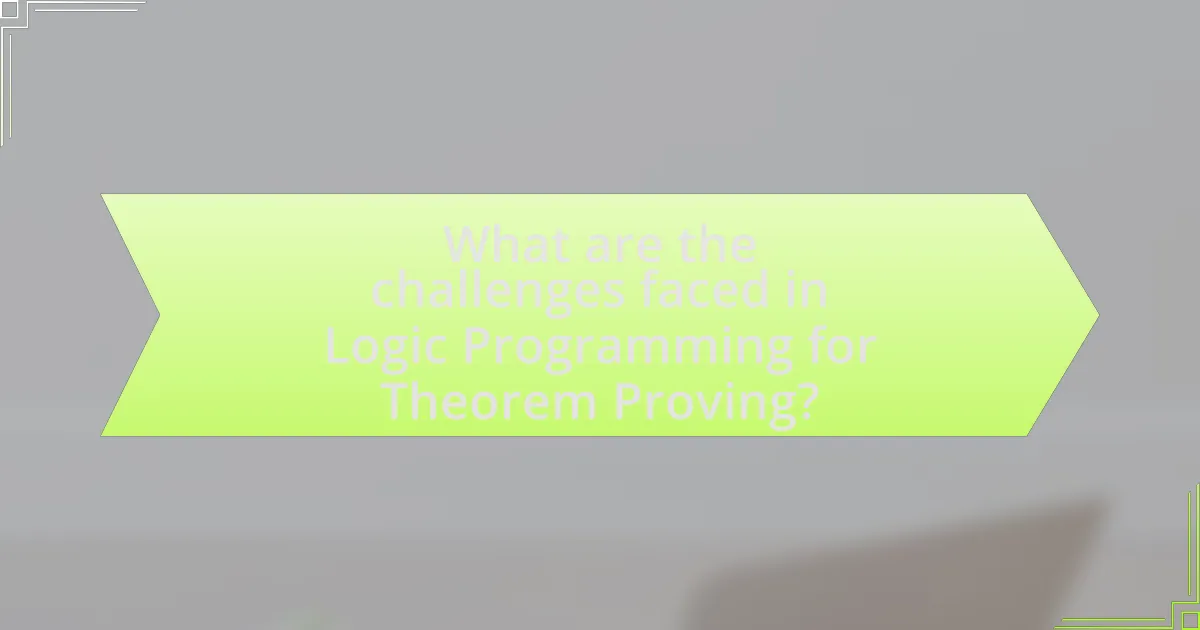
What are the challenges faced in Logic Programming for Theorem Proving?
Logic programming for theorem proving faces several challenges, including expressiveness, computational complexity, and scalability. The expressiveness challenge arises because certain logical constructs may not be easily represented in logic programming languages, limiting the ability to model complex problems. Computational complexity is significant, as many theorem proving tasks can be NP-hard or worse, making them computationally intensive and time-consuming. Scalability issues occur when attempting to apply logic programming to larger problems or datasets, often leading to performance degradation. These challenges hinder the effectiveness and efficiency of logic programming in practical theorem proving applications.
What limitations exist within Logic Programming methodologies?
Logic Programming methodologies face several limitations, including inefficiency in handling large datasets and difficulty in expressing certain types of problems. These methodologies often struggle with performance issues, particularly in terms of execution speed and memory usage, as they rely heavily on backtracking and unification processes. Additionally, Logic Programming can be less intuitive for representing complex real-world scenarios, which may require more expressive power than what traditional logic can provide. For instance, the inability to easily represent non-monotonic reasoning or uncertainty can hinder its applicability in dynamic environments.
How do complexity issues affect Theorem Proving?
Complexity issues significantly impact theorem proving by determining the feasibility and efficiency of proof search algorithms. High complexity can lead to intractable problems, making it difficult to find proofs within a reasonable time frame. For instance, certain logical systems exhibit exponential time complexity, which means that the time required to solve problems increases exponentially with the size of the input. This has been evidenced in studies such as “Complexity of Theorem Proving” by John McCarthy, which highlights that many decision problems in logic are NP-complete, indicating that no polynomial-time algorithms are known for these problems. Consequently, complexity issues can limit the practical applicability of theorem proving in real-world scenarios, as they may require excessive computational resources or time to derive valid conclusions.
What are common pitfalls in Logic Programming applications?
Common pitfalls in Logic Programming applications include inefficiencies in search strategies, difficulties in handling incomplete information, and challenges in managing side effects. Inefficient search strategies can lead to excessive computation time, as seen in Prolog applications where backtracking may explore large search spaces unnecessarily. Handling incomplete information often results in ambiguous or incorrect conclusions, which can undermine the reliability of theorem proving. Additionally, managing side effects, such as state changes in predicates, complicates reasoning and can lead to unintended consequences, making it difficult to maintain logical consistency. These pitfalls highlight the importance of careful design and implementation in Logic Programming to ensure effective and reliable applications.
How can these challenges be addressed?
To address the challenges in using logic programming for theorem proving, researchers can enhance algorithms and frameworks that support automated reasoning. For instance, improving the efficiency of resolution-based methods can significantly reduce computational overhead, as demonstrated by advancements in Prolog systems that optimize backtracking and search strategies. Additionally, integrating machine learning techniques can help in identifying patterns and heuristics that streamline the theorem proving process, as evidenced by studies showing that hybrid approaches yield faster proof generation times.
What strategies can improve the efficiency of Logic Programming?
Strategies to improve the efficiency of Logic Programming include optimizing search algorithms, employing constraint logic programming, and utilizing efficient data structures. Optimizing search algorithms, such as depth-first search or breadth-first search, can significantly reduce the time complexity of problem-solving tasks. Constraint logic programming enhances efficiency by allowing the specification of constraints that limit the search space, leading to faster solutions. Additionally, using efficient data structures, like hash tables or balanced trees, can improve the speed of data retrieval and manipulation, which is crucial in theorem proving contexts. These strategies are supported by empirical studies demonstrating that optimized algorithms and data structures can lead to performance improvements of up to 50% in various logic programming applications.
How can practitioners mitigate complexity in Theorem Proving?
Practitioners can mitigate complexity in theorem proving by employing modularization techniques, which allow for breaking down proofs into smaller, manageable components. This approach enhances clarity and reduces cognitive load, making it easier to verify each part independently. Additionally, utilizing automated theorem proving tools can streamline the process by handling repetitive tasks and providing assistance in proof construction. Research indicates that these methods significantly improve efficiency and accuracy in theorem proving, as evidenced by studies demonstrating reduced proof times and increased success rates in complex proofs.

What are the future trends in Logic Programming and Theorem Proving?
Future trends in Logic Programming and Theorem Proving include increased integration with machine learning techniques, enhanced automation in proof generation, and the development of more user-friendly interfaces for non-experts. The integration with machine learning allows for the optimization of theorem proving processes, as seen in projects like Lean and Coq, which leverage AI to assist in proof discovery. Enhanced automation is evident in systems like Isabelle and Agda, which are evolving to reduce the manual effort required in formal proofs. Additionally, the focus on user-friendly interfaces is driven by the need to make these powerful tools accessible to a broader audience, as demonstrated by initiatives aimed at simplifying the syntax and semantics of logic programming languages.
How is artificial intelligence influencing Logic Programming?
Artificial intelligence is significantly influencing logic programming by enhancing its capabilities in automated reasoning and theorem proving. AI techniques, such as machine learning and neural networks, are being integrated into logic programming systems to improve their efficiency and effectiveness in solving complex problems. For instance, AI-driven tools can analyze vast datasets to identify patterns and generate hypotheses, which logic programming can then formalize and verify. This synergy allows for more robust theorem proving, as seen in projects like Coq and Lean, where AI aids in automating proof generation and verification processes, thus streamlining the development of formal proofs in mathematics and computer science.
What advancements are being made in automated theorem proving?
Recent advancements in automated theorem proving include the integration of machine learning techniques to enhance proof search efficiency and the development of more expressive logical frameworks. For instance, systems like Lean and Coq have incorporated tactics that leverage machine learning to predict proof strategies, significantly reducing the time required for complex proofs. Additionally, the introduction of higher-order logic and dependent types in theorem provers has expanded their applicability to more intricate mathematical domains, as evidenced by the work of researchers such as Adam Chlipala and others who have demonstrated the effectiveness of these approaches in formalizing complex mathematical concepts.
How might Logic Programming evolve with new technologies?
Logic Programming may evolve with new technologies through the integration of machine learning and artificial intelligence, enhancing its capabilities in theorem proving. The combination of these technologies can lead to more efficient algorithms that automate the proof process, allowing for the handling of more complex problems. For instance, recent advancements in neural-symbolic integration demonstrate how machine learning can improve the performance of logic-based systems by learning from data while maintaining logical reasoning. This evolution is supported by research indicating that hybrid systems, which combine logic programming with machine learning techniques, can outperform traditional methods in various applications, including automated theorem proving.
What practical applications can be derived from Logic Programming in Theorem Proving?
Logic programming in theorem proving has practical applications in automated reasoning, formal verification, and knowledge representation. Automated reasoning systems utilize logic programming to derive conclusions from premises, enabling the automation of proofs in various domains such as mathematics and computer science. Formal verification employs logic programming to ensure that software and hardware systems adhere to specified properties, thereby preventing errors and enhancing reliability. Knowledge representation benefits from logic programming by allowing complex information to be structured and queried effectively, facilitating intelligent systems and artificial intelligence applications. These applications demonstrate the versatility and effectiveness of logic programming in enhancing theorem proving processes.
How is Logic Programming applied in real-world problem-solving?
Logic programming is applied in real-world problem-solving through its use in automated theorem proving, enabling systems to derive conclusions from a set of axioms and rules. For instance, Prolog, a prominent logic programming language, is utilized in artificial intelligence for tasks such as natural language processing and expert systems, where it can efficiently handle complex queries and reasoning tasks. The effectiveness of logic programming in these applications is evidenced by its ability to formalize and solve problems in various domains, including mathematics, computer science, and engineering, where logical inference is crucial for validating theorems and ensuring correctness in software development.
What industries are leveraging Logic Programming for Theorem Proving?
The industries leveraging Logic Programming for Theorem Proving include computer science, artificial intelligence, formal verification, and telecommunications. In computer science, Logic Programming is utilized for developing algorithms that ensure software correctness. The artificial intelligence sector employs it for knowledge representation and reasoning tasks. Formal verification, particularly in safety-critical systems like aerospace and automotive, uses Logic Programming to prove system properties. Telecommunications companies apply it to optimize network protocols and ensure reliable communication systems. These applications demonstrate the versatility and importance of Logic Programming across various sectors.
What best practices should be followed in Logic Programming for Theorem Proving?
Best practices in Logic Programming for Theorem Proving include using clear and concise definitions, structuring proofs systematically, and employing modular design. Clear definitions enhance understanding and reduce ambiguity, while systematic structuring, such as following a logical progression from premises to conclusions, ensures clarity in reasoning. Modular design allows for the reuse of components, facilitating easier debugging and maintenance. These practices are supported by the success of established logic programming languages like Prolog, which emphasize clarity and structure in theorem proving tasks.
